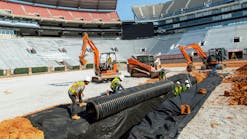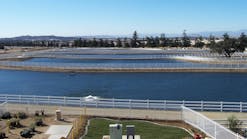Investing in Intelligent Infrastructure
About the author:
Jennifer Rusch is senior public involvement specialist, water, for Burns & McDonnell. Rusch can be reached at [email protected].
Combined sewer systems (CSS) exist in as many as 860 communities across the nation, and these aging sewer systems account for an estimated 850 billion gal of untreated wastewater overflow each year. To address this issue, CSS communities across the U.S. are anticipated to pay in excess of $57 billion to reduce combined sewer overflows (CSOs), primarily through revenue generated from increased wastewater rates charged to customers.
The detention basin achieved 92% wet weather volume reduction from April 2017 to April 2018.
A Challenge Like No Other
Kansas City, Mo., is among the many CSS communities that feel the financial burden of investing in an aging sewer infrastructure system. In September 2010, the city embarked on the largest infrastructure investment in its 180-year history when the U.S. EPA approved Kansas City’s $4.5 billion consent decree to reduce an estimated 6.4 billion gal of annual CSOs by the year 2035. To generate the funding necessary to reduce sewer overflows by more than 85%, the city’s program would require 10 years of wastewater rate increases. In 2018, after nine years of rate increases, household bills in Kansas City are rapidly nearing EPA’s guidelines for median household income burden.
“This is a critical issue for Kansas City and for other cities facing similar infrastructure needs,” said Andy Shively, special assistant city manager in charge of the Kansas City Smart Sewer program. “We have more data and more technology than ever before, and that comes with a responsibility to leverage those resources to protect our most precious resource—our people.”
Currently home to the biggest and most connected Smart City in North America, Kansas City issued a challenge in 2016 to bring the innovative and sustainable solutions necessary to help the city realize $1 billion in cost efficiencies and help mitigate the burden of the city’s $4.5 billion wastewater investment.
Among the first to accept Kansas City’s Billion Dollar Smart Infrastructure Challenge was local partner and program manager, Burns & McDonnell, and Opti RTC Inc., a technology company based in Boston, Mass.
“Kansas City is setting the standard when it comes to implementing smart infrastructure technologies at scale,” said Micah Strauss, project manager for Opti. “City leaders are proactively looking for ways to implement technology to find cost-effective ways to meet the consent decree objectives.”
One of the Billion Dollar Smart Infrastructure solutions Kansas City adopted is Continuous Monitoring and Adaptive Control (CMAC), a technology developed by Opti designed for intelligent storm water management. CMAC technology autonomously controls the timing and rate of storm water flow into CSS using cloud-based technology, water level sensors and actuated valves. Using these components, CMAC systems are able to observe onsite conditions in conjunction with National Oceanic and Atmospheric Administration weather forecasts to plan and predictively respond to storm events in real time.
The system reduces storm water management costs for rate payers.
A Worthwhile Investment
The city, along with its partners at Burns & McDonnell and Opti, implemented CMAC at an existing 1.1-million-gal storm water detention basin, named for its street location at Gardner Avenue. The dry basin was constructed with local flood control in mind and discharges to the CSS. Prior to implementing CMAC at the Gardner Avenue storage facility, city staff had to manually close and open the storm water gate before and after anticipated storm events. This manual operation was not effective due to the amount of planning and man-hours required to operate the facility.
“As stewards of Kansas City’s smart sewer program, we are constantly looking for ways to measure, optimize and adapt the city’s existing infrastructure,” said Andy Sauer, project manager for Burns & McDonnell. “In this case, the program team was able to retrofit 21st century technologies into an existing detention basin, which proved to be much more cost effective than building a new storm water solution.”
The Gardner Avenue CMAC system has been in place for more than a year with an estimated cost of $0.02 per gallon managed, and that cost is expected to decrease in the second year of operation. Kansas City considers this investment to provide value, compared to other storage solutions that have ranged in cost from $3.50 to more than
$8 per gallon.
In addition to providing cost savings, the use of CMAC technology has helped the city of Kansas City to utilize its existing assets. Based on the information available to the city at the onset of the Gardner Avenue project, teams anticipated that the CMAC-controlled detention basin would hold storm water runoff for a period of 12 hours before slowly releasing the runoff into the CSS. However, through the use of CMAC technology, teams learned that holding the runoff for longer periods—up to 40 hours in some instances—produced greater levels of infiltration and evaporation, and reduced the amount of storm water that would be required for release back into the CSS.
This, combined with the large surface area of the project site, allowed the technology to keep the outlet valve at Gardner Avenue closed during the entirety of a wet weather event rather than modulating the outlet valve. By using data to learn more about infiltration rates at Gardner Avenue, then adapting the moderation of the outlet valve accordingly, the team was able to achieve 92% wet weather volume reduction from April 2017 through April 2018.
Due to the success of the Gardner Avenue project, Kansas City already has implemented the same storage solution, at its Chestnut Avenue storm water detention basin, which is located in the same combined sewer basin. For the typical rainfall event, this basin now will be able to capture approximately 70,000 gal of runoff, which is equivalent to approximately 0.5 in. of runoff. Kansas City reports that the CMAC system installed at Chestnut Avenue Aug. 11, 2018, already has produced results. Forty-eight hours after installation, Kansas City experienced a rain event that produced 0.5 in. of rainfall. As designed with CMAC, the Chestnut Avenue detention basin captured 100% of that rainfall event, proving the immediate success of this technology. Kansas City considers this project to be a model of its vision for the Billion Dollar Smart Infrastructure Challenge.
The system successfully captured 100% of a rainfall event that produced 0.5 in. of rainfall.






